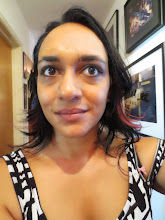The politics of the exhibition are pronounced without being shrill or strident. These artists apply a feminist sensibility to a 21st century context, assuming that women have professional and personal autonomy and choice, while asserting that feminist consciousness remains a necessity even in the face of some progress. For example, Gail Wight's installation, The Meaning of Miniscule, turns a feminist lens on the sciences, where women are admitted provided that they subdue their femininity and adhere to a rationalist agenda proscribed by that field's mostly male gatekeepers. Lest I paint too severe a picture, this installation is also great fun, consisting of an oversized microscope with a video "slide" that the viewer can control using the knobs on the scope's stem. One knob sorts through historical renderings of microbial organisms, while the opposite one generates sound bytes of knowledgeable-sounding science show hosts spouting empty yet authoritative pronouncements. A sequence of photo prints of shattered test tubes add an element of chance, further supporting Wight's riff on the pomposity of scientific certainty.
Gail Wight, The Meaning of Miniscule, 2006
Maria Antelman's contribution is a cryptic film comprised of still images with an apparently incoherent soundtrack. Further investigation reveals that the images were shot inside the disused NASA hangar at Moffett Field in Mountain View, north of San Jose, and that the voiceover is reading Hamlet's "to be or not to be" soliloquy translated into Klingon. The juxtaposition of two incomprehensible parts, each of which implies militancy despite its opaqueness, is both strange and comical. Adding to the charm is the fact that Antelman is a skilled photographer of arresting visuals.
Maria Antelman, tah pagh taHbe, 2006
Jean Shin's sculpture, TEXTile, is a rumpled carpet made of computer keys. A screen at one end is connected to an activated keyboard at the other. The keys spell out the full text of Shin's email correspondence with the Fabric Workshop and Museum in Philadelphia, who originally commissioned the work. The activated keyboard is also comprised of this text, so that a visitor wishing to type messages onto the screen must hunt for keys amid the words. Shin has long worked in a participatory manner, using social networks to gather the materials and subjects of her installations. Her use of technology in this piece furthers that interaction with her audience, while complicating our relationships to familiar and ubiquitous tools.
Jean Shin, TEXTile, 2006
Julia Page's video Heir Apparent frames and highlights the obsessive media scrutiny paid to First Daughters Luci Baines Johnson, Tricia Nixon, Amy Carter and Chelsea Clinton. Their awkwardness is heartbreaking, and their self-awareness jarring. Adolescent girls, they are trapped in that most embarrassing time of life, yet on display to the world as tokens of American power, affluence and "family values."
Julia Page, Heir Apparent, 2004
Stephanie Syjuco contributes her first-ever video work, Body Double, a three-channel silent film about the use of her native Philippines as a stand-in for Vietnam in American war movies. Syjuco made her first trip back only recently, and before this she grew up seeing images that treated her country of origin solely as a stand-in for the most contentious conflict region in recent American history (until now).
Stephanie Syjuco, Body Double, 2006
The video consists of three classic Vietnam War films - Apocalypse Now, Platoon and Hamburger Hill. Syjuco blacks out all areas of the image that don't show the Filipino landscape, whether because actors appear in the frame or because the action takes place elsewhere. As such, one or more screens is black for much of the time, interrupted by rectangular excerpts of foliage and water. Even stripped of its context, the river featured in Apocalypse Now is instantly recognizable. Hollywood's appropriation of the Filipino landscape causes its jungles and rivers to be some of the most iconic and familiar in our culture, though we as a nation understand little of the Philippines.
There is plenty of work in this show that deserves mention, more than I can talk about here. It's well worth the drive into the heart of darkness (well, Oakland) to see this show.

1 comment:
Thanks for sharing this awesome piece of info. It is really very helpful.
hotmail email
Post a Comment